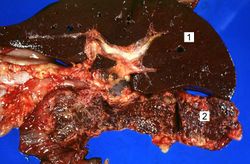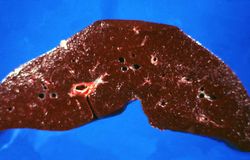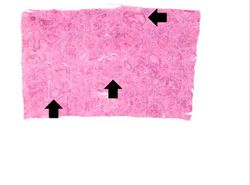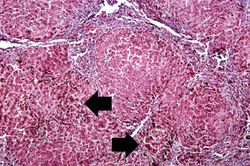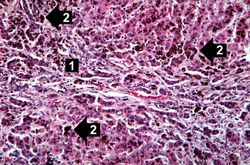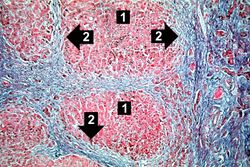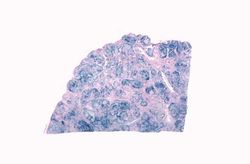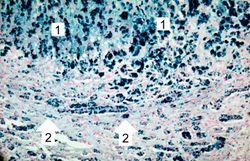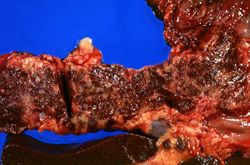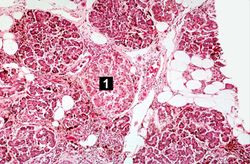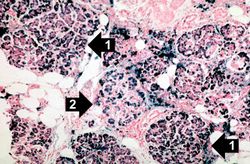Difference between revisions of "IPLab:Lab 5:Hemochromatosis"
Seung Park (talk | contribs) |
Seung Park (talk | contribs) |
||
| Line 28: | Line 28: | ||
Wilson's Disease is also an autosomal recessive disorder that results in the accumulation of toxic levels of copper. Like hemochromatosis, the gene defect has been localized but the exact nature of the genetic defect is unknown. In this disorder, copper absorption and transport to the liver are normal; however, the copper does not get back into the circulation as ceruloplasmin and copper excretion into bile is severely impaired. The accumulation of copper leads primarily to liver, brain and eye damage. The liver develops fatty change and nuclear vacuolization in the setting of acute or chronic hepatitis which later progresses to cirrhosis. Neurologic manifestations include toxic neuronal injury primarily in the basal ganglia. Accumulation of copper in the cornea results in the formation of Kayser-Fleischer rings.</spoiler> | Wilson's Disease is also an autosomal recessive disorder that results in the accumulation of toxic levels of copper. Like hemochromatosis, the gene defect has been localized but the exact nature of the genetic defect is unknown. In this disorder, copper absorption and transport to the liver are normal; however, the copper does not get back into the circulation as ceruloplasmin and copper excretion into bile is severely impaired. The accumulation of copper leads primarily to liver, brain and eye damage. The liver develops fatty change and nuclear vacuolization in the setting of acute or chronic hepatitis which later progresses to cirrhosis. Neurologic manifestations include toxic neuronal injury primarily in the basal ganglia. Accumulation of copper in the cornea results in the formation of Kayser-Fleischer rings.</spoiler> | ||
| + | |||
| + | == Additional Resources == | ||
| + | === Reference === | ||
| + | * [http://emedicine.medscape.com/article/177216-overview eMedicine Medical Library: Hemochromatosis] | ||
| + | * [http://www.merckmanuals.com/professional/hematology_and_oncology/iron_overload/overview_of_iron_overload.html Merck Manual: Iron Overload: Hemosiderosis and Hemochromatosis] | ||
| + | |||
| + | === Journal Articles === | ||
| + | * Ayonrinde OT, Milward EA, Chua AC, Trinder D, Olynyk JK. [http://www.ncbi.nlm.nih.gov/pubmed/18712630 Clinical perspectives on hereditary hemochromatosis]. ''Crit Rev Clin Lab Sci'' 2008;45(5):451-84. | ||
| + | * Bassett ML. [http://www.ncbi.nlm.nih.gov/pubmed/11456037 Haemochromatosis: iron still matters]. ''Intern Med J'' 2001 May-Jun;31(4):237-42. | ||
| + | |||
| + | === Images === | ||
| + | * [http://peir.path.uab.edu/library/index.php?/tags/177-hemochromatosis PEIR Digital Library: Hemochromatosis] | ||
| + | * [http://library.med.utah.edu/WebPath/LIVEHTML/LIVERIDX.html#3 WebPath: Hepatic Pigmentary Disorders] | ||
| + | * [http://library.med.utah.edu/WebPath/CINJHTML/CINJIDX.html#5 WebPath: Cellular Accumulations] | ||
| + | |||
| + | == Related IPLab Cases == | ||
| + | * [[IPLab:Lab 13:Biliary Atresia|Lab 13: Liver: Biliary Atresia]] | ||
{{IPLab 5}} | {{IPLab 5}} | ||
[[Category: IPLab:Lab 5]] | [[Category: IPLab:Lab 5]] | ||
Revision as of 20:38, 22 August 2013
Contents
Clinical Summary[edit]
This 61-year-old female was first admitted to the hospital because of ascites and pedal edema. A liver biopsy revealed a marked intracellular accumulation of iron. The serum iron concentration was reported as 220 mcg/dL. On the basis of these studies, the diagnosis of hemochromatosis was made. It should be noted that the patient also exhibited an abnormal glucose tolerance curve at this time (following the ingestion of a test dose of glucose, the blood glucose level rose to 290 mg/dL at one hour and remained at this level for the next three hours). Subsequent to the first admission, the patient was admitted on several occasions for ascites. The patient's last admission was necessitated by the development of symptoms and signs of hepatic failure (hepatic coma) characterized by jaundice and coma.
Autopsy Findings[edit]
The liver weighed 800 grams. The cut surface was described as golden-brown in color, having a fine, diffuse nodularity, and being extremely firm in consistency.
Images[edit]
Study Questions[edit]
- Compare and contrast the pathogenesis and clinical features of hemochromatosis and Wilson’s disease.
Additional Resources[edit]
Reference[edit]
- eMedicine Medical Library: Hemochromatosis
- Merck Manual: Iron Overload: Hemosiderosis and Hemochromatosis
Journal Articles[edit]
- Ayonrinde OT, Milward EA, Chua AC, Trinder D, Olynyk JK. Clinical perspectives on hereditary hemochromatosis. Crit Rev Clin Lab Sci 2008;45(5):451-84.
- Bassett ML. Haemochromatosis: iron still matters. Intern Med J 2001 May-Jun;31(4):237-42.
Images[edit]
- PEIR Digital Library: Hemochromatosis
- WebPath: Hepatic Pigmentary Disorders
- WebPath: Cellular Accumulations
Related IPLab Cases[edit]
| |||||
Normal serum iron levels are 35 to 160 micrograms/dL.
After glucose challenge, the blood glucose level should be back to 110 to 180 mg/dL by 2 hours.
Jaundice (or icterus) is a state of hyperbilirubinemia (increased bilirubin in the blood) in which bile pigment is deposited in the skin, mucous membranes, and scleras. This deposition of bile pigment results in a yellow appearance.
The normal weight of the right lung in an adult is 450 grams (range: 360 to 570 grams).
Cirrhosis is a liver disease characterized by necrosis, fibrosis, loss of normal liver architecture, and hyperplastic nodules.
